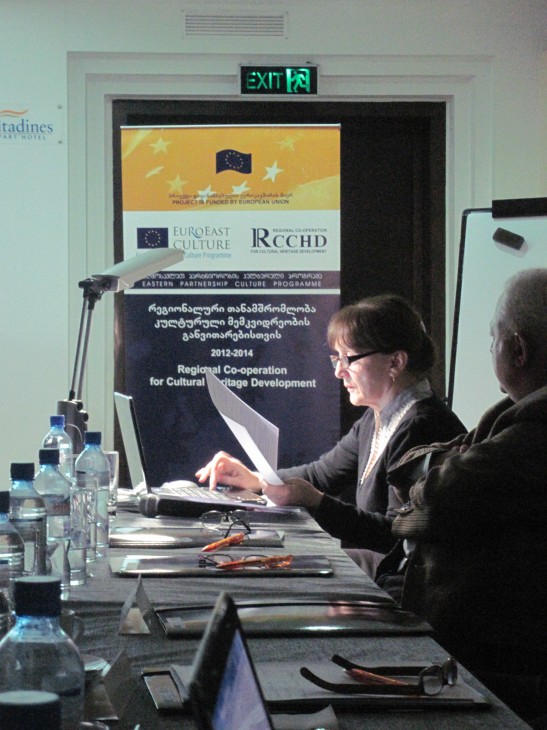
A group of stakeholders from Armenia, Azerbaijan, Georgia, Norway, and Ukraine with experience planning, implementing and analyzing cultural heritage policies on different levels, had gathered in Tbilisi. The purpose of the Workshop was to exchange experience accumulated in each country, to share best practices as well problems related to the workshop topic, and finally, to strengthen professional links within the EaP region and Europe.
Notes from the 3rd International Capacity-Building Workshop: “National Policy of Heritage Sector”
Thursday, December 06, 2012
Introductory presentation by Morton Stige: “Universal Challenges in the Heritage Sector: criteria for success.” Examples from Oslo, Norway of how to address the four universal problems of the heritage sector: lack of public awareness, political support, legal tools for planning and developing the sector, and economic incentives.
Asnaya Shukurova: national policy on heritage in Azerbaijan.
Malahat Farajova: creating a new museum complex at Gobustan National Historic Artistic Reserve. The site was continuously inhabited by many cultures over centuries, creating opportunities and challenges in museum development. A partnership was formed with the Smithsonian Institution, supporting Native American and Azerbaijani petroglyphs.
Yuriy Losytskyy and Olga Vasylchenko: cases from Ukraine (Kyiv). Use of street certification as an instrument to conserve architectural heritage and the character of historic neighborhoods.
Gagik Gyurjian: approaches to Armenian heritage policies of the last decade.
Tsintsino Chachkhunashvili: Rude interventions in Georgian historic towns (Mtskheta and Batumi). Problems include incompatible modern additions (adding more floors) and infill designs, as well as state intervention in modern investments (Technical University in Batumi).
Manana Suramelashvili: metamorphosis of historic architecture. Buildings in Old Tbilisi are no longer being repaired or restored, but completely reconstructed with no reference to their original historic forms.
Maia Mania: current construction projects in Kala district (Old Tbilisi).
Friday, December 07, 2012
Discussion of preservation issues in Tbilisi: maintaining context, appreciating craftsmanship and historic building techniques, and developing laws and regulations on heritage. Suggestions by Nato Tsintsabadze for adoption of regulations and management plans.
Morton Stige: conflicts between new developments and heritage values in an urban context: examples from Oslo, Norway. Necessity for discussion about new construction that still respects the old; made the point that Tbilisi suffers problems from two extremes: no investment, and too much investment. Examples from Oslo facilitated discussion of problems such as aggressive development, inappropriate additions and infill design, and heritage listing.
Post-lunch discussion on Georgia’s 2008 law regarding cultural heritage protection. Laws should be improved by adding clarifications about which stakeholders have which powers and responsibilities, and what the consequences should be if policies are violated. Effective laws should also provide more suggestions for practical actions. Whether the law should be replaced or amended was discussed.
Notes by Angela Wheeler , the Fulbright Program Fellow.











|
Heritage Conservation Regional Network Journal

|
|
Introducing_Young_People_to_the_Protection_of_Heritage_Sites ENG
Details »
|
|
Networking |
Policies |
|
|
Public awareness |
Workshops |
|
 The project is funded by the
The project is funded by the European Union
EU is not responsible
for the content of this website
 |
 |
 |
 |
 |
 |
 |
 |
 |
|
RCCHD Project: Office 16b, Betlemi ascent, 0105 Tbilisi, Georgia Tel.: +995 32 2-98-45-27 E-mail: rcchd@icomos.org.ge |
© 2012 - Eastern Partnership Culture Programme |





